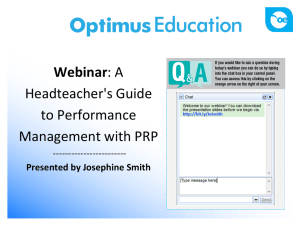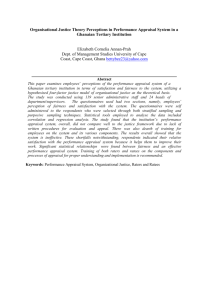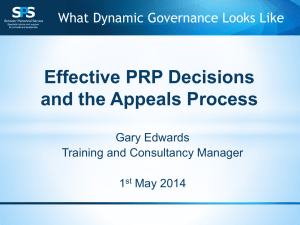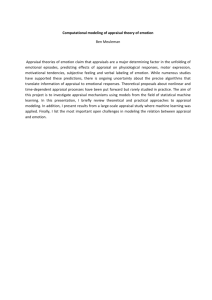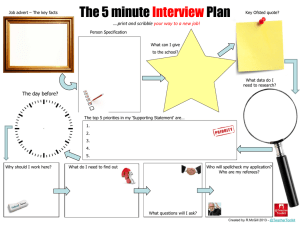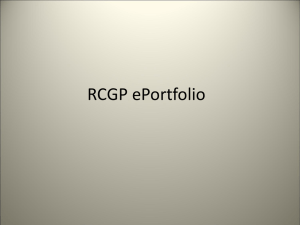PowerPoint version
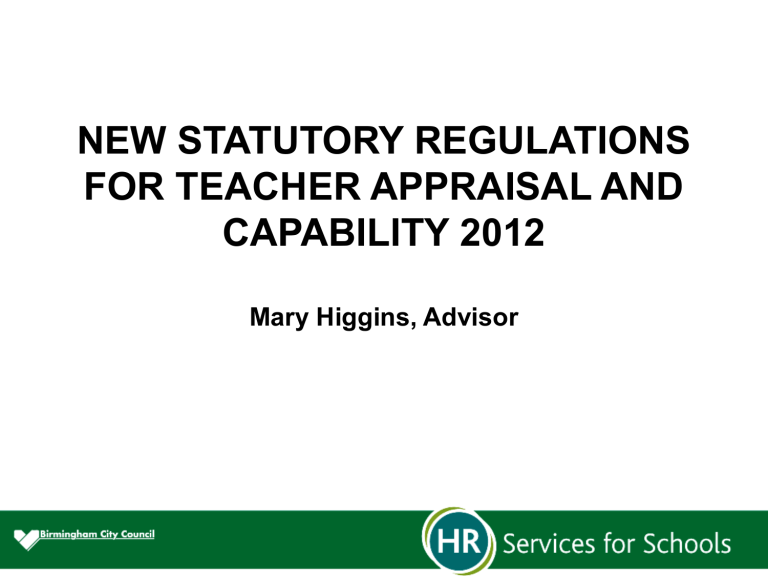
NEW STATUTORY REGULATIONS
FOR TEACHER APPRAISAL AND
CAPABILITY 2012
Mary Higgins, Advisor
Objectives
• Familiarise school leaders with changes to Teacher
Appraisal and capability regulations and process
• Provide an opportunity to consider the new Teachers’
Standards
• Respond to questions and concerns
• Identify future needs
• Consultation
The Challenge
“ I want to ensure that all my teachers are at least good without any hindrance or bureaucracy ”
“This is a bully’s charter, if we are not careful”
“The next thing will be a staff shortage”
“What are we going to do with all these satisfactory teachers?”
Context
• Expectation that all teaching will be consistently at least
“good”
Teachers’ Standards (2011) and Ofsted 2012 grade descriptor of “Good” match significantly
“Satisfactory” grade to be replaced with “requires improvement”
• Teachers’ Standards provide criteria for what does a good job look like?
• What does a good job look like? (Including professional conduct)
Teachers’ Standards
• High expectations
• Good (secure) and curriculum knowledge
(including English)
• Accurate and productive use of assessment
Ofsted 2012 Grade Descriptors
(Good)
• Teachers have high expectations
• Well developed subject knowledge, teaching, reading, writing and communication is very efficient
• Accurate assessment of pupils’ prior skills, … to plan effectively and set challenging tasks
Teachers’ Standards
• Plan and teach well structured lessons
set homework
promote a love of learning
Ofsted 2012 Grade Descriptors
(Good)
• Appropriate and regular homework to enthuse and motivate
• Manage behaviour effectively
• ….Strategies for managing and improving behaviour applied consistently, disruptive incidents seldom occur
• Teachers’ Standards provide criteria for what does a good job look like?
• Other standards expected
Post Threshold/AST/Excellent Teachers
Accepted by S of S for consideration by STRB
Standards – how I must work day in\day out?
Objectives - what I should achieve?
Local Context
• Level of DFE monitoring in Birmingham
• Ensuring success of school to school support
• Recent Ofsted inspections – first mention of leadership and management being “too slow” in dealing with underperformance
Our Preferred Approach
• Build on what you have already…..in majority of schools,
PM is robust! No need for complete revision
• Supportive recognising that the majority of teachers want to do a good job
• Leadership enabling good performance is a key function
• A duty of care -
Preparation is everything
No surprises!
Keep it simple!
• Fairness
• Consistency
Principles
• Balance
• Enablement
• Confidentiality
Key Features of Best Quality
Performance Management
• CLARITY of expectations
What does a good job look like in our school for our pupils?
“Code of practice?”
Key question – Have you already got an understanding?
Are you sure?
• ALIGNMENT to School Improvement Plan
• CONSISTENCY
across all leaders at every level
the “message” - and the practice!
-
(inconsistency – a performance issue)
Key question – How do you make sure there is consistency now?
• ROBUST systems/activities and record-keeping to provide evidence
• ON-GOING DIALOGUE
• LINK to other policies
CPD
Teaching and learning
(Pay Policy, Managing Sickness Policy revision by
LA)
Regulations
Governing Bodies required to:-
• Establish an annual appraisal policy for teachers
• Appoint an external adviser to support appraisal of
Headteacher
• Ensure objectives are set for each teacher
• Annual appraisal
• Each teacher receives their appraisal report to include
assessment of performance
assessment of development needs
recommendation on pay progression (if applicable)
What’s the difference between current and new?
• Limit on observation removed
• Assessment against Teachers’ Standards
(and any other relevant standards)
• No overlap between performance management and capability, “a seamless process”
The Policy
• LA recommend the National Model Policy (Part A only)
Part B. Capability Procedure – work in progress
• Appraisal period – academic year
• Appointing appraisers – as previously
• Setting objectives – as previously (October 31 st )
• SMART
No limit on numbers but will be recognised across all sectors that, where there are no or very few issues,
3 is still reasonable
Pupils progress in key area(s)
Wide contribution to improving provision
Professional development
• Teachers’ Standards
All teachers – Teachers’ Standards 2011 plus other relevant sets of standards published by the Secretary of
State
• Reviewing performance
• Include all your systems, processes which will provide robust evidence of a teacher’s performance, eg book scrutiny, PPR’s, data analysis, “voice”
Balancing your
Judgement
Observation of
Teaching
Internal and External
Voice
• Pupil
• Parent
• External partners
Teacher
Scrutiny of Learning
Outcomes
• Pupil progress reviews
• Book scrutiny
• Test/Exam Results
• Data Analysis
• Observation
As per policy as you are doing now and for the majority of teachers
• Development and Support
As per policy and as you are probably doing now
• Feedback
As per policy
Annual Assessment
As per policy
Capability Procedure
• As document… still consulting on whether we should clarify further, eg. timelines?
• You will need and receive ER support anyway! Contact early!
Making links to the Ofsted Framework for the Quality of
Teaching – to what extent do teachers understand and use the criteria to self-reflect and offer professional advice to colleagues?
Have all staff understood and agreed what is meant by key components of effective teaching and learning such as progress, pace and depth of learning?
What evidence could teachers use to exemplify these aspects?
In order to ‘keep their knowledge and skills as teachers up-to-date and are selfcritical’ how does the leadership use the performance management process to foster a learning ethos and support staff to evaluate the impact of any CPD?

